सौर मंडल के सबसे बड़े क्रेटरों की सूची
Following are the largest craters on various worlds of the Solar System.
| पिंड | क्रेटर | व्यास | स्वामी पिंड का व्यास |
अनुपात | नोट्स | |
|---|---|---|---|---|---|---|
| बुध | Caloris Basin | 1,550 कि॰मी॰ (963 मील) | 4880 | 32% | 
| |
| Rembrandt | 715 कि॰मी॰ (444 मील) | 15% | 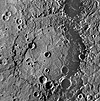
| |||
| शुक्र | Mead | 280 कि॰मी॰ (170 मील) | 12,100 | 2% | 
| |
| पृथ्वी | Vredefort | 250–300 km (160–190 mi) | 12,740 | 2% | 
| |
| चंद्रमा | Procellarum Basin | 3,000 कि॰मी॰ (1,900 मील) | 3470 | 86% | Not confirmed as an impact basin. | |
| दक्षिण ध्रुव-ऐटकेन घाटी | 2,500 कि॰मी॰ (1,600 मील) | 70% | 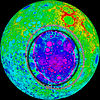
| |||
| Mare Imbrium | 1,145 कि॰मी॰ (711 मील) | 33% | 
| |||
| मंगल | North Polar Basin | 10,600 × 8,500 km (6,550 × 5,250 mi) | 6780 | 140% | 
|
Not confirmed as an impact basin |
| Hellas Planitia | 2,300 कि॰मी॰ (1,400 मील) | 34% | 
|
Largest visible crater in the Solar System | ||
| Utopia Planitia | 3,300 कि॰मी॰ (2,100 मील) | 49% | 
|
Largest confirmed impact basin on Mars and in the Solar System | ||
| वॅस्टा | Rheasilvia | 505 कि॰मी॰ (310 मील) | 529 (569)[1] | 90%[1] | 
|
See also List of tallest mountains in the Solar System |
| Veneneia | 395 कि॰मी॰ (250 मील) | 70%[1] | 
|
Partially obscured by Rheasilvia | ||
| Ganymede (Jupiter) | Epigeus | 343 कि॰मी॰ (213 मील) | 5270 | 6½% | ||
| Callisto (Jupiter) | Valhalla | 360 कि॰मी॰ (224 मील) | 4820 | 7½% | 
| |
| Heimdall | 210 कि॰मी॰ (130 मील) | 4% | ||||
| Mimas (Saturn) | Herschel | 139 कि॰मी॰ (86 मील) | 396 | 35% | 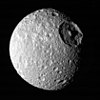
|
See also List of tallest mountains in the Solar System |
| Tethys (Saturn) | Odysseus | 445 कि॰मी॰ (277 मील) | 1060 | 42% | 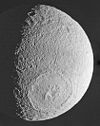
| |
| Dione (Saturn) | Evander | 350 कि॰मी॰ (220 मील)[2] | 1023 | 34% | 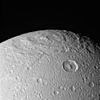
| |
| Rhea (Saturn) | Mamaldi | 480 कि॰मी॰ (300 मील)[3] | 1530 | 31% | 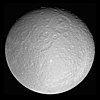
| |
| Tirawa | 360 कि॰मी॰ (220 मील) | 24% | 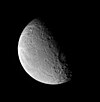
| |||
| Titan (Saturn) | Menrva | 392 कि॰मी॰ (244 मील) | 5150 | 7½% | ||
| Iapetus (Saturn) | Turgis | 580 कि॰मी॰ (360 मील) | 1470 | 39% | 
| |
| Engelier | 504 कि॰मी॰ (313 मील) | 34% | 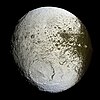
| |||
| Gerin | 445 कि॰मी॰ (277 मील) | 30% | 
|
Gerin is overlain by Engelier | ||
| Falsaron | 424 कि॰मी॰ (263 मील) | 29% | ||||
| Titania (Uranus) | Gertrude | 326 कि॰मी॰ (203 मील) | 1580 | 21% | 
|
Little of Titania has been imaged, so it may well have larger craters. |
सन्दर्भ
- ↑ अ आ इ Rheasilvia and Veneneia are 95% and 75% of the mean diameter of Vesta, 529 km. However, the mean is affected by the craters themselves. They are 89% and 69% the mean equatorial diameter of 569 km.
- ↑ "USGS". मूल से 22 सितंबर 2019 को पुरालेखित. अभिगमन तिथि 7 अक्तूबर 2014.
- ↑ "USGS". मूल से 18 फ़रवरी 2018 को पुरालेखित. अभिगमन तिथि 7 अक्तूबर 2014.